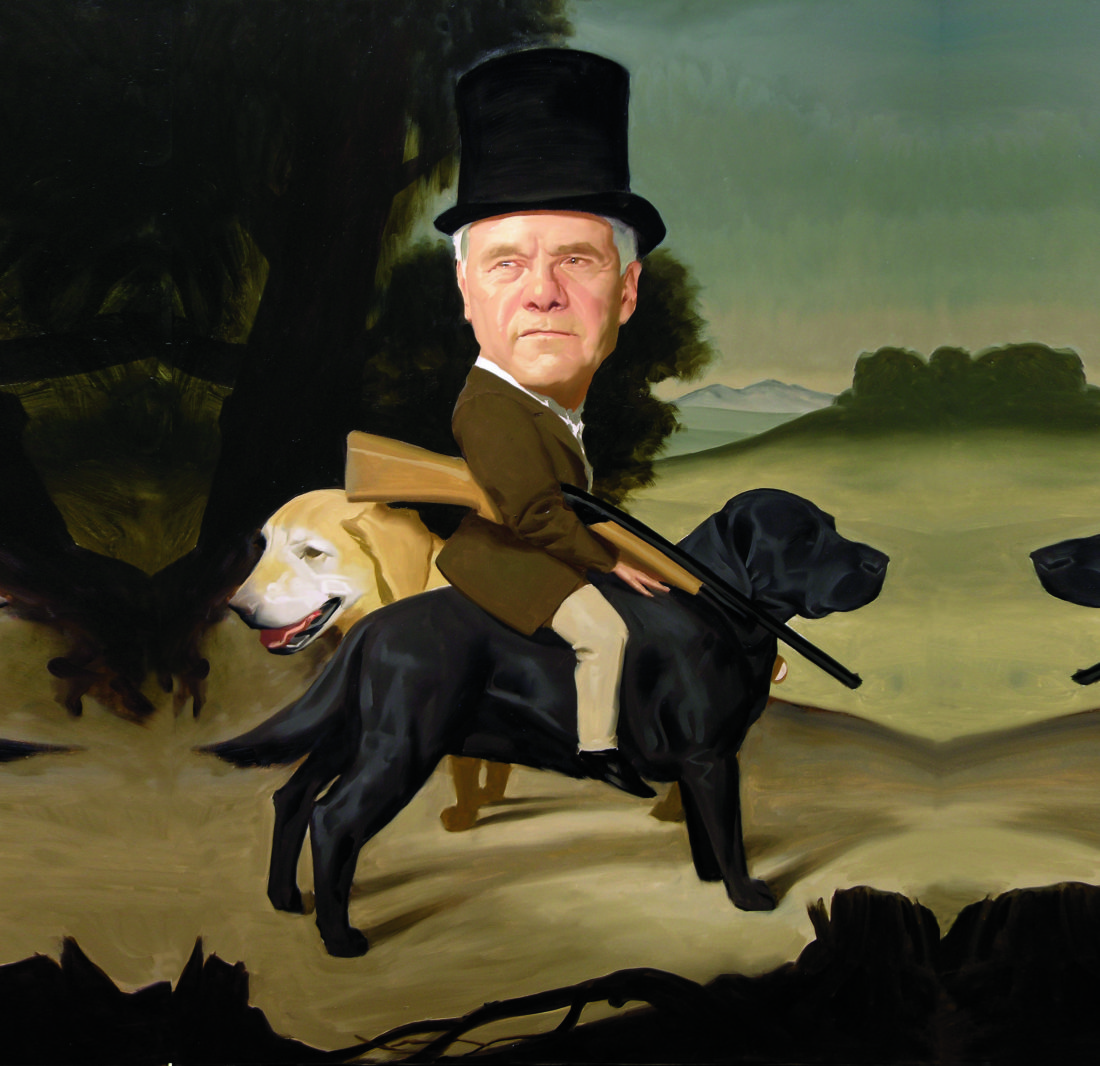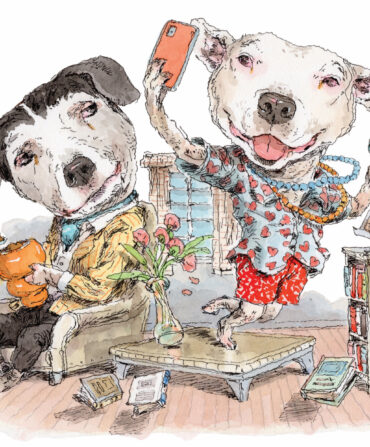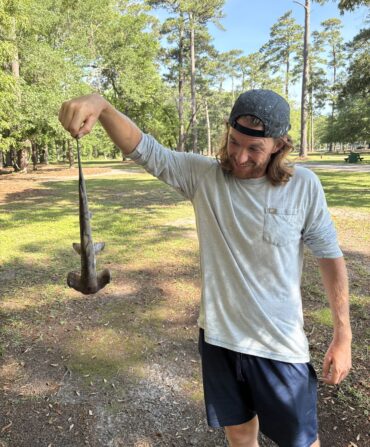This is the story of two Labrador ladies: one, an elegant, highly intelligent, and self-confident blonde, the other, her kissing cousin, a tautly shaped raven-haired bundle of energy and anxiety. The blonde was known to a wide circle of admirers as Sage the Wonder Dog. The cousin was called Abbie, a name assigned by her Scottish breeders before she arrived in our family at the age of two.
My wife, Meredith, and I have been so willing to arrange our lives to accommodate Sage and Abbie that in a vain attempt to re-claim some dignity we say aloud from time to time, “Good God, we’re the kind of people we used to make fun of.” It doesn’t change our behavior, but we do take some comfort in acknowledging our weakness in their presence.
They, in turn, demand nothing more than regular meals, soft beds, hands-on affection, and deep grass hillsides or fields of grain so they can exercise their God-given abilities to find upland birds, send them aloft, and, if their master doesn’t screw up, retrieve for him the shotgunned quarry.
But I am ahead of myself.
We were empty nesters, our last-born child having departed for Duke. Meredith decided we needed a dog to fill the vacuum. She heard about a litter in Colorado sired by Chopper, the legendary avalanche dog at the top of Aspen Mountain.
Sage came from that litter first to our ranch in Montana, where from her earliest age she demonstrated a unique combination of curiosity and what can only be described as canine self-confidence. She seemed to know she had royalty in her bloodline.
When Sage arrived, she was nameless and remained so for several weeks as we struggled to find the right call sign while remembering the admonition to pick a name that also serves as a command. Preferably one syllable and punchy.
We were struggling until a family friend suggested running through the spices. Rosemary and thyme may work for Paul Simon but not for a bird dog. But Sage? Yes. Perfect, especially for a dog already showing signs of innate wisdom and, besides, she was starting life nosing through the sagebrush on the surrounding hills.
Sage seemed to understand that her moniker brought with it certain expectations of self-confidence and making the right choices.
Shortly before acquiring Sage, I had edged back into shooting again after a hiatus brought on by the lethal consequences of 1968 when two of my heroes, Dr. Martin Luther King, Jr., and Robert F. Kennedy, were gunned down. I had moved up from the Remington Wingmasters of my South Dakota youth to my friends’ over-and-under Berettas and Purdeys at their exclusive shooting clubs in New York.
My eye had not left me, and the old thrill of nailing a pheasant on afterburners had returned. I began to wonder, could this new dog become a boon companion in the field?
From her earliest days with us she was nose down and tail up whenever we wandered into the hills surrounding our ranch, endlessly curious and focused.
I called a well-known trainer in upstate New York, Jerry Cacchio, who came highly recommended. He set the tone quickly. “You celebrities all think you’ve got a bird dog. You’ll have to leave her with me for six weeks at least before we find out.” We hesitated, but agreed that, however Sage turned out, the training would be helpful for her as a pet.
Three weeks after we dropped her off, Cacchio called to say, “Come get your dog.” Damn, I thought, she flunked out. “No,” Cacchio assured me. “You’re a lucky guy. This is a smart dog. I can’t teach her much more. You and I are going to spend a lot of time together.”
It was a conversation that changed my life. I had a bird dog. Now the challenge was to get her into the field as swiftly as possible. And so began one of the unexpected but altogether harmonic experiences of my life, an annual rite of man, dog, friends, guns, and cackling roosters in the autumnal glory of the high plains or the quick flush of Hungarian partridge and sharptail grouse in the sagebrush-dotted landscape of Park County, Montana.
On our first trip back to South Dakota, my hunting pals were simultaneously skeptical and patronizing: “A New York dog, here in the mother lode of wily wild pheasants, competitive canines, thick cover, country boy shooters, and hunting as high church? Ho ho.”
Two memories from those first hunts will linger forever. Sage was in a post-puppy phase, still finding her way when we hunted with friends in a sprawl of vast cornfields. I had left the main party with Sage to work her in a more isolated corner of the grain when I heard Meredith shouting to send her back. My friend Emmett had downed a rooster, and the other dogs had not been able to find it in the jungle of unpicked corn spilling over the horizon.
“A New York dog, here in the mother lode of wily wild pheasants, competitive canines, thick cover, country boy shooters, and hunting as high church? Ho ho”
I said simply to Sage, “Go to Meredith,” and she sprinted off a hundred yards to the main party. Meredith pointed to the general area where the pheasant had gone down and said, “Sage, get the bird.” Sage turned and rocketed into the standing stalks for a few moments and then came strolling out with a dead pheasant locked firmly in her jaws. Sage dropped the retrieved bird at Meredith’s feet and raced back to join me in our corner of the field.
Emmett turned to Meredith and said, “You know, it’s a shame that dog has to live in a New York apartment. Why don’t you leave her here with me?” Nice try, no deal.
The following autumn Sage sat up in the passenger compartment of the plane I had chartered to central South Dakota as we drifted down to a small strip near Platte, a farming community in the heart of corn, soybean, and cattle country. Sage’s ears were cocked and her nostrils were wide before we taxied to a stop. She was a long way from her New York home, but she knew exactly where she was and what was expected of her.
For the next three days she put on a gold medal performance of finding, flushing, and retrieving a rich harvest of wild pheasants in corn, beans, sunflowers, grass, and tree rows, moving at a steady, fluid gait with no episodes of whining or yelping while she gave equal attention to the eight hunters she was serving.
In a deep ravine hard by the Missouri River, the prairie grass had grown so thick it created a long, winding tunnel of cover along the dry creek bed at the bottom. Sage quickly determined it was the equivalent of a pheasant bunker, and she fearlessly dove in and disappeared from view. But we could track her by the nervous movement of the grass speeding along in two distinct clumps: first, pheasants racing through what they thought was their sanctuary, followed closely by Sage.
We raised our guns, knowing this couldn’t go on forever and then—boom—at one end, the roosters exploded into the cerulean sky, followed by a streaking blur of golden dog fur. Bang, bang—one, two roosters went down, but one managed to get airborne again, however momentarily. Sage leaped four feet into the air and snatched it back to earth.
My friend Terry Ring, the soft-spoken proprietor of Silver Creek Outfitters, Sun Valley’s premier gun and fly fishing shop, turned to me and said matter-of-factly, “I’ve been doing this a long time; I don’t think I’ve seen a better dog.”
That night I retreated to my bedroom to read, and Sage went along. I was in bed with a book and Sage resting her head on my chest when a college friend looked in on us. I could tell from his expression that he would have been less jealous if I had won the Nobel Peace Prize.
From that day and night on, Sage was not just my dog; she was my mistress and no one was more understanding than Meredith.
When Sage was tight by my side on the sidewalks of New York, cornfields and CRP plots of the Great Plains, sage-covered hills of Montana, and streamside as I fished through the summer months, we moved seamlessly through a zone of serenity, bound by deep mutual affection and dependence.
It was a pattern happily repeated season after season and then enhanced by the arrival of Abbie when Sage was eight years old.
On her baptismal trip to South Dakota, Abbie was confused. She’d been trained to retrieve, not to flush, so on opening day she stayed close by my side in the first field while Sage reconnoitered the landscape. After a few moments Sage simply looked back over her shoulder at Abbie, as if to say, “Okay, rookie, let me show you a trick or two.”
I sent Abbie to Sage’s side and then hit but did not kill a feisty rooster who immediately went into the evade-and-escape mode. As the pheasant darted off, Sage led Abbie on a serpentine track, her nose down and tail up, until they caught up to the wounded bird and brought it back to my feet.
Later on that cold and windy day, I dispatched Sage to help my friends hunt a band of trees bordering a cornfield while I kept Abbie with me to work on her commands. My back was to a barbed wire fence that separated the field from a ditch and a gravel road when a cackling rooster throttled out of the tree line just as a carload of local hunters stopped on the road to watch the action. I swung my 20-gauge hard from left to right, thinking, “Please, God, don’t let me blow this shot in front of the good ol’ boys.” It was a clean kill over the road, and the big cock pheasant went down in the deep grass of the far ditch.
I released Abbie, who took four strides, cleared the fence in a powerful yet graceful leap, and streaked to the far side of the road where she grabbed the pheasant and returned it swiftly to my side. As she resumed her sitting position, the carload of locals broke into whistles and cheers.
I’ve interviewed presidents and royalty, rock stars and movie stars, famous generals and captains of industry; I’ve had front row seats at Super Bowls, World Series, and Olympic Games; my books have been on best-seller lists, and my marriage is a long-running success. That day with Sage and Abbie is right up there when I come to reckon, “How did one guy get so lucky?”
I shot a double of sharptail grouse, and Sage, for the first time in her life, didn’t know where they were. Her eyesight, hearing, and now her matchless nose were going fast
Somewhere in the deep recesses of my mind and heart, however, I knew this couldn’t go on forever. Somewhere out there beneath an ominously gray sky of late autumn in the American West, when the birds were blitzing the steady winds, the day would come when Sage and Abbie would make their final retrieve.
That each would do that with élan and dignity in her own way is one more tribute to their individual and collective place in that part of my soul I reserve for greatness that I’ve encountered.
When Sage turned thirteen, I knew the day was fast approaching. She was hobbled by arthritis, and her hearing was as dim as my own. Still, she maintained her essential majesty, never more elegantly than when I returned from a long, difficult trip to Iraq and stumbled into our bedroom for a recuperative nap. As I lay down I could hear Sage laboriously working her way up the stairs to our bedroom. Just as I was about to drift off, she somehow managed to struggle onto our bed and stretched out beside me, placing her head affectionately on my shoulder as if to say, “Welcome home, partner. I missed you.”
A few weeks later we were back in Montana for a snowy weekend of shooting Hungarian partridge. My friend Ron had flown in from Los Angeles, and we both knew this was going to be tough duty for my aging ladies, Sage and Abbie.
They were game, but the birds were scattered by the storms and so we spent a couple of hours trudging through deep snow and up slippery hills. As we were walking back to my pickup, we passed a thick hawthorn bush on a steeply pitched hillside leading into a marsh belly deep in white, wet snow.
Without a word from me, Sage did a sharp right turn and plunged into the bush. I shouted to Ron to be ready, and he clocked a partridge forty yards out in the snowy marsh grass. Sage was on the retrieve, making her way through the drifts like a swimmer stroking against the tide. She collected the little gray bird and turned back to us, the most difficult part of her journey still ahead as we stood atop the pitched embankment.
Abbie rushed down, trying to claim the retrieve, but Sage just patiently turned her head until Abbie sheepishly backed off and allowed Sage to make her way steadily to our side. Ron and I were speechless.
Four days later Sage and I were in the sagebrush on another hillside. I shot a double of sharptail grouse, and she, for the first time in her life, didn’t know where they were. Her eyesight, hearing, and now her matchless nose were going fast.
The following summer we buried her in Montana in a grove of aspens on a hillside overlooking the river where she frolicked with me on my morning plunges and stood as a sentry while I cast for rising trout, awaiting autumn and rising birds.
Abbie lived on but she, too, began to break down, and no combination of drugs or surgery could delay the onset and penalty of withered limbs.
My hunting days were now the province of Red, another yellow Lab, a boy’s boy, athletic, and another superior dog in the field. In Abbie’s thirteenth year I gathered my gun, shells, and whistle from the locked closet in our Montana farmhouse and started out with Red for an afternoon of grouse.
Abbie rallied herself from the sleeping pad and gave me such a mournful look that I succumbed and said, “Okay, you get to go, too.” She waggled all the way to the four-wheeler, where I lifted her in beside me and drove to a tall stand of bluestem and timothy bordered by chokecherry bushes leading to a sharp incline.
Red was bouncing through the vegetation, onto something, just what, I didn’t know, as Abbie followed me through the waist-high grass. Suddenly, Red put up a covey of blue grouse and a separate covey of ruffed grouse simultaneously.
I killed a ruffed and winged a blue at the top of the ridgeline. Red went after the dead bird, and I said to Abbie, “Okay, old girl, we have to find the other.” It was a hard, hot hike straight uphill. When we reached the top, I looked around and Abbie was missing. “My God,” I thought, “she’s died of a stroke or a heart attack.”
Then, out of the corner of my eye, I saw a black ball of fur tumbling down from the top of the hill, pushing a wounded grouse ahead with her nose. Abbie, her legs now worn out, was sliding and rolling the bird into the bushes where she could trap it against the thick roots. When she reached the bushes, she grabbed the blue in her jaws and lay down, waiting for me to retrieve them both. I pocketed the grouse, picked up Abbie, and carried her down the hill, weeping softly as I kept repeating into her ear, “Good girl, good girl.”









